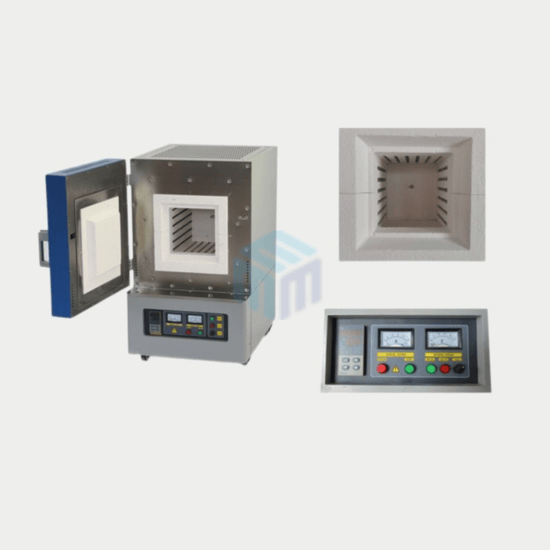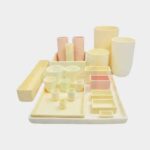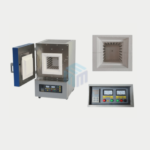Muffle furnaces play a crucial role in laboratories, industrial plants, and research environments across Australia. These high-temperature furnaces are designed to provide consistent, clean, and controlled heating for a wide range of thermal processes such as ashing, sintering, material testing, and heat treatment.
Whether you’re working in materials science, ceramics, metallurgy, or chemical analysis, understanding how a muffle furnace works—and which type best suits your needs—can significantly improve accuracy, efficiency, and repeatability in your operations. This guide offers a comprehensive look at muffle furnace working principles, key features, applications, types, and buying considerations tailored for Australian users.
How Does a Muffle Furnace Work? (Working Principle Explained)
A muffle furnace operates by heating a chamber that contains the sample, while insulating it from the heating elements. This design ensures consistent, isolated, and clean heating, ideal for analytical or high-purity applications.
Heating Element & Insulation
The heating elements (often made from Kanthal, molybdenum disilicide, or silicon carbide) surround the furnace chamber and are insulated with ceramic fibre or refractory materials to ensure thermal efficiency and safety.
Temperature Control System
Modern muffle furnace laboratory come with digital PID temperature controllers, enabling precise temperature control, ramping, and holding profiles. High temperature muffle furnaces Models like 1200°C, 1400°C, 1600°C and 1800°C are commonly used across Australian labs for varied testing conditions.
Separation of Sample and Heat Source (The “Muffle” Concept)
The muffle design keeps samples isolated from combustion gases and direct contact with the heating coils, ensuring a clean environment—perfect for chemical analysis, ashing, and thermal treatments where contamination can compromise results.
Key Features of Muffle Furnaces
High-Temperature Capability
Muffle furnaces can easily reach and maintain temperatures from 1200°C up to 1800°C, making them suitable for demanding thermal processing applications.
Uniform Heating
The enclosed chamber and advanced insulation ensure uniform temperature distribution, a critical factor for repeatable and reliable test outcomes.
Contamination-Free Environment
Ideal for analytical and sensitive work, muffle furnaces provide a clean, controlled atmosphere that prevents chemical interference with samples.
Precise Temperature Control
With advanced digital controls and safety cut-offs, users can program exact heating cycles for applications like sintering ceramics or determining ash content.
Read also: Distinguish Between Industrial Furnaces and Lab Furnaces
Common Applications of Muffle Furnaces
Heat Treatment of Metals and Alloys
Used in metallurgy labs and small-scale production, furnaces for laboratories allow controlled annealing, tempering, and hardening of metal samples.
Ash Content Determination
Essential in food, plastic, and coal industries, muffle furnaces help in burning off organic material to measure ash content accurately.
Ceramic and Glass Manufacturing
Muffle furnaces are integral in the sintering and glazing processes for advanced ceramics, glass components, and dental prosthetics—dental furnaces are a specialised category of muffle furnaces.
Material Testing and Research Labs
Universities and research facilities across Australia use muffle furnaces in R&D for materials science, metallurgy, and chemical engineering.
Chemical Analysis & Sample Preparation
In analytical chemistry, muffle furnaces support sample prep by removing organic matrices through high-temperature ashing, improving the accuracy of elemental analysis.
Types of Muffle Furnaces
Box-Type Muffle Furnace
These are the most common and versatile, used in general lab applications with large chamber space and easy access for samples.
Tube Muffle Furnace
Ideal for continuous flow experiments or gas-reactive processes, these furnaces allow controlled atmospheres via quartz or alumina tubes.
Benchtop Muffle Furnace
Compact and efficient, benchtop models are perfect for academic labs, dental labs, and small-scale testing facilities.
Industrial Muffle Furnace
Built for high-volume or heavy-duty applications, these furnaces are robust, larger, and often custom-built to suit production environments.
Factors to Consider Before Buying a Muffle Furnace
Temperature Range
Choose based on your application—1200°C muffle furnaces are sufficient for general lab use, while 1600°C models are better for ceramic sintering and advanced metallurgy.
Chamber Size
Ensure the internal dimensions suit your sample volume and size. Oversizing can waste energy, while undersizing can limit functionality.
Material of Construction
Look for durable insulation, corrosion-resistant inner linings (like alumina), and strong exterior casings for long-term reliability.
Control Systems and Safety Features
Modern muffle furnaces offer digital controllers, over-temperature protection, and programmable features for precise operation and user safety.
Maintenance Tips for Long-Lasting Performance
- Allow proper cool-down after each use before reopening the chamber.
- Avoid thermal shock—do not place cold items into a hot furnace.
- Clean ash and residues regularly using a soft brush (once cooled).
- Calibrate and inspect temperature sensors periodically.
- Check for insulation wear or cracks, especially around the door seal.
Proper care ensures your high-temperature muffle furnace remains reliable and safe for years.
Conclusion
Whether you’re operating in a university lab, a metallurgical facility, or a ceramics workshop, a muffle furnace is an essential piece of equipment for high-temperature, clean, and precise heating tasks. With options ranging from benchtop laboratory furnaces to heavy-duty industrial units, selecting the right model can significantly improve your workflow, results, and repeatability.
Looking for a Reliable Muffle Furnace in Australia?
At M-Kube, we offer a wide selection of laboratory and industrial muffle furnaces built for Australian standards and backed by expert support.
📞 Call +61-3-9876-7766 or 📧 Email info@mkube.com.au
🔗 Explore Our Muffle Furnace Range ( )
FAQs
What is a muffle furnace used for?
A muffle furnace is used for high-temperature applications such as ashing, heat treatment, sintering, and material analysis in laboratories and industrial settings.
What is the minimum temperature for a muffle furnace?
Most muffle furnaces start at ambient temperature and can operate from around 100°C to 1200°C/ 1400°C/ 1600°C/ 1800°C, depending on the model.
Can muffle furnaces be used for organic material ashing?
Yes, they are ideal for removing organic matter from samples—widely used in food, polymer, and coal testing for ash content determination.
What industries commonly use muffle furnaces?
Industries include chemical labs, metallurgy, dental labs, ceramics, glass manufacturing, and educational research institutions.






